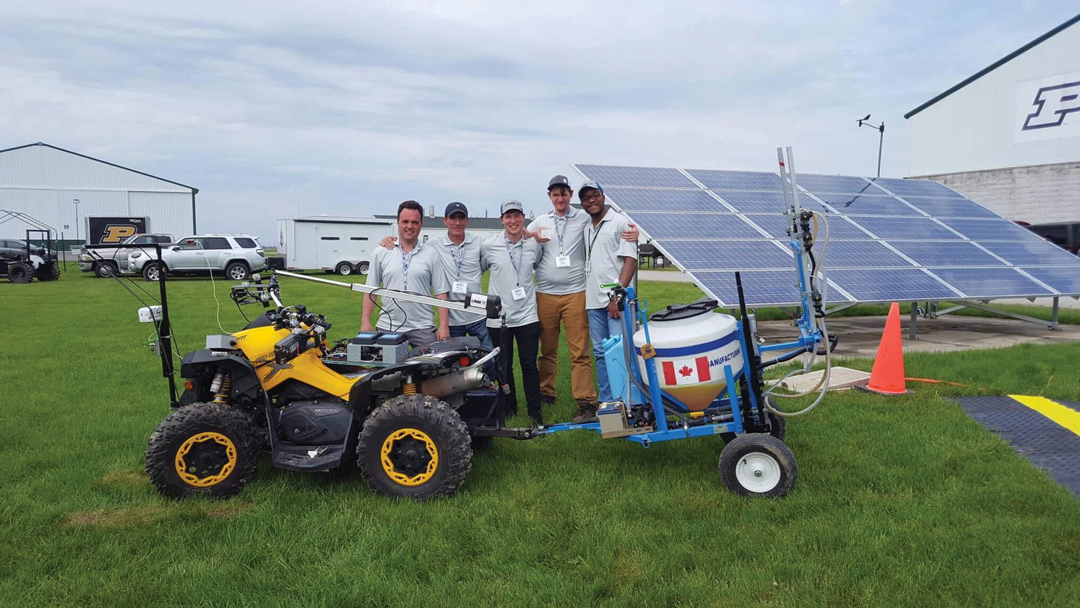AGBOT ACTION
BY ELLEN COTTEE • PHOTO COURTESY OF UNIVERSITY OF MANITOBA UM-AGBOT TEAM
Rockville, IN, farmers Steve Gerrish and daughter Rachel knew that with better rural access to broadband internet service, the potential of automated technology to solve agricultural problems could be expanded. To illustrate this, they launched the annual agBOT Challenge in 2015, which they held at their family farm. The robotic equipment featured in this team competition typically employs wireless internet to carry out agricultural tasks.
The Gerrishs partnered with Indiana’s Purdue University to co-present the ag robotics competition held May 16-18, 2019. The event’s new mandate is to get participants and attendees to envision how automated technology can transform agriculture. Challenge teams build robotic vehicles that compete in two areas. In the category of weed and feed, agBOT Challenge teams are tasked with creating autonomous machines able to navigate a corn field, disperse fertilizer and identify and spray various types of weeds found throughout the crop. In the competition’s second category, which focuses on soil diagnostics, battling bots collect soil samples, autonomously preparing them for analysis. Event judges score machines on their performance and ease of operation.
Ronald Turco, head of the university’s agronomy department, said the competition has allowed Purdue students to grasp just how far agricultural technology has advanced and how much further it must go.
Many agBOT competitors do not have agricultural backgrounds, but are students of engineering or computer programming. “This gives them a whole different perspective on the world and where they can put their skills to work,” said Turco. “They also bring a new mind to the problem of automation in farming.”
The competition has opened the eyes and ambitions of students and ag-industry professionals well beyond its home state. The agBOT competitors primarily include graduate students attending American and Canadian universities. Canadian winners have included a team from Muchowski Farms of Odessa, SK, that took third place in 2016 for a non-functional seeder prototype and the same spot in 2017 with a functional automated seeder. The team secured another third-place finish in 2018 with a harvest bot. As well, a team of engineers from the University of Regina took first place in the 2016 seeding challenge with an unmanned seeder.
The 2019 competition was held on the university grounds at the Purdue Agronomy Center for Research and Education in West Lafayette, IN, as part of the school’s NextGen Expo. The outdoor, public technology exhibition focuses on technological advancements in farm management, agronomy and related areas.
Virginia Tech won the overall competition with an elaborate autonomous mobile soil lab.

The UM-agBOT club fielded a team comprised of University of Manitoba Biosystems Engineering students, some with farm backgrounds, others not. Competing for the first time, the team won third place in the weed and feed category with an ATV-mounted bot that utilized a front-mounted video camera to identify weed varieties and spray each appropriately.
“The project has helped us pick up an impressive range of skills that would be difficult to get in a classroom,” said team member Franklin Ogidi. “The skills we are developing put us at the forefront of robotics, remote sensing, precision agriculture and automation and give us an edge in the tech market space.”
Launching the group and fielding an agBOT Challenge team proved a struggle that required a whole support community, including three university departments and corporate sponsors, according to Ogidi.
“Participating in the project has helped shed more light on the potential for innovation in the agriculture industry and specifically, how we could get involved in pushing this innovation as biosystems engineers,” he said.








Comments